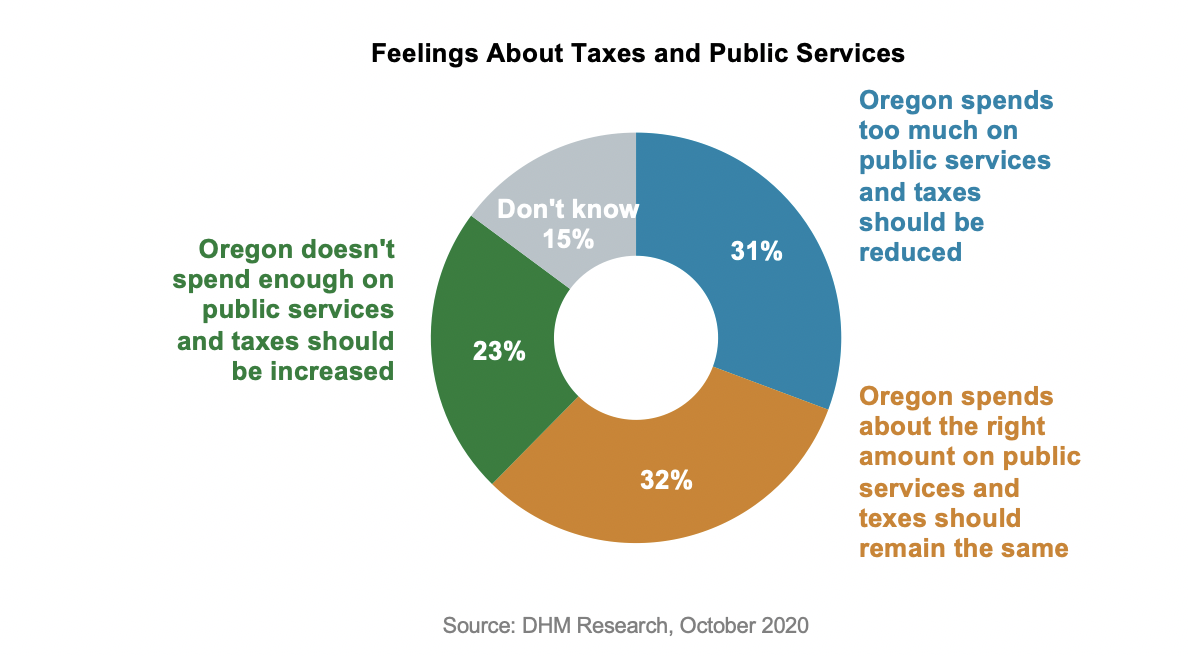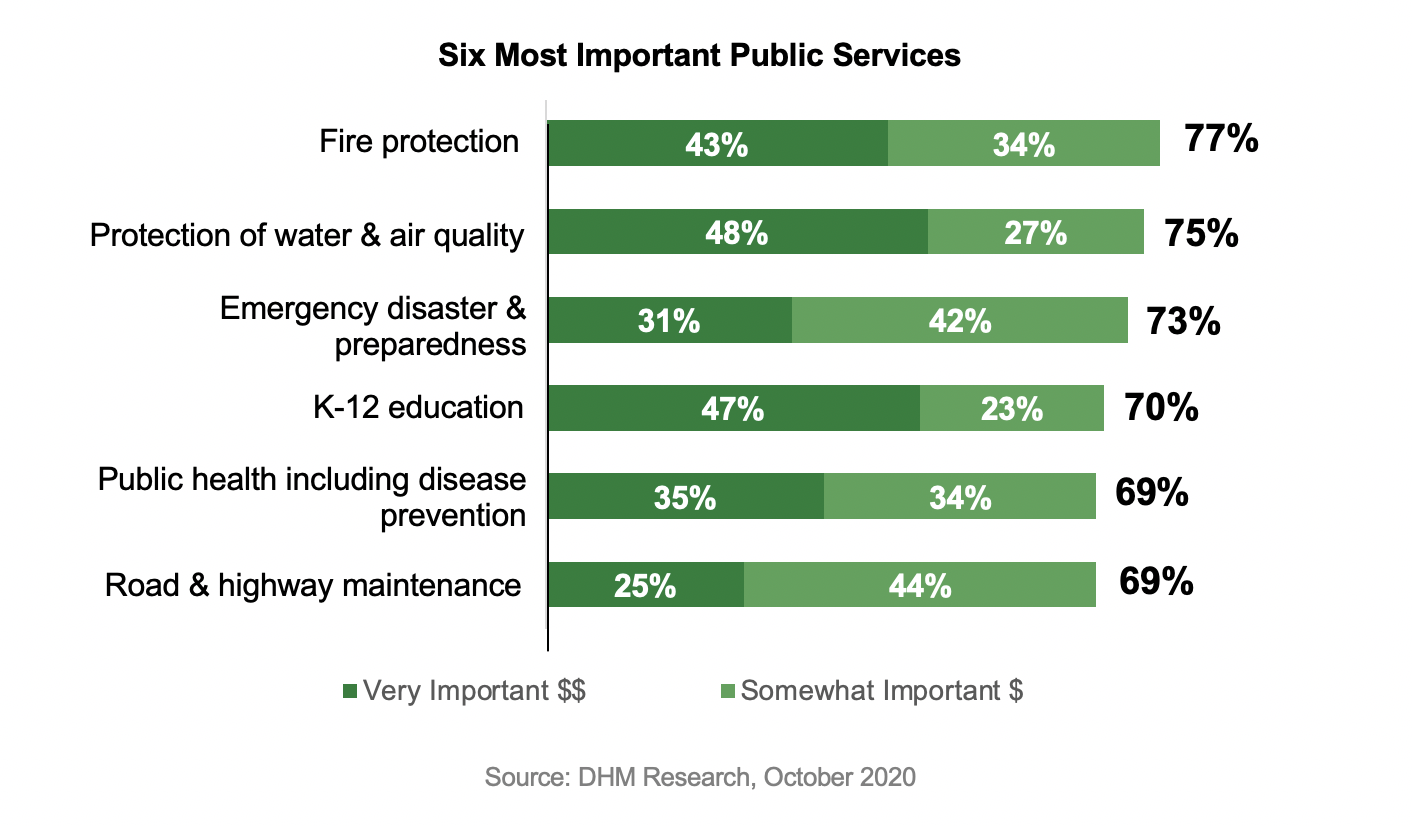These findings come from a DHM Research (DHM) and Oregon Values and Beliefs Center (OVBC) online survey conducted from October 1 to October 6, 2020 about a variety of issues including COVID-19, climate change, homelessness, and public finance and taxation.
Quality control measures were taken including pretesting the questionnaire and randomizing questions to reduce order bias. Demographic quotas and statistical weighting were also used to ensure a representative sample of 600 Oregonians ages 18+. The margin of error for each question falls between +/-2.4% and +/-4.0% at the 95% confidence level, depending on how the response category percentages split for any given question. The percentages report below may not add to 100% because of rounding.
Taxation for Public Services
Oregonians are split in their feelings about taxes and public services with about a third each feeling we spend too much on public services and taxes should be reduced (31%) and another third feeling we spend about the right amount and taxes should remain the same (32%). About a quarter of Oregonians (23%) feel we do not spend enough on public services and taxes should be increased, and 15% were unsure.

Tri-county and Democrats were more likely than their counterparts to feel that Oregon does not spend enough on public services and taxes should be increased. Women were less likely than men to feel Oregon spends too much on public services. Women were also more likely to be unsure as were respondents ages 18-44.
This split in feelings about what we spend on public services has been with us for a while. In 2013, the numbers were similarly split: 30% too much, 31% right amount, 28% not enough, and 10% unsure.
Oregonians feel that both small businesses and individuals pay about the right amount (30%/31%) or too much (46% 48%) in Oregon state taxes. On the other hand, they feel large businesses pay too little (61%). Across all three groups (small businesses, large businesses, individuals), Tri-county and Democrats were more inclined than their counterparts to feel the group is paying too little in taxes.
Importance of Public Services
Respondents were asked to indicate the importance of 21 different public services ranging from public safety like police to 4-year colleges-see attachment below. They were provided the following information to use for their ratings:
- Very or somewhat important means you would support some increase in your taxes to increase the service or some reallocation of tax dollars away from other existing services
- Neutral means you do not want more tax dollars to go to that service even if that means a diminished level of the service over time
- Somewhat or very unimportant means you want fewer or no taxes to go to that service now and that it should be reduced or discontinued entirely
Considering combined very or somewhat important, the highest rated services were fire protection (77%), protection of water and air quality (75%), and emergency disaster and preparedness (73%). K-12 education was 70% followed by two at 69%: public health including disease prevention, and road and highway maintenance.

Three of these services were rated by more than 40% of Oregonians as very important: protection of water and air quality (48%), K-12 education (47%), and fire protection (43%). Only one other service was above 40% very important: publicly funded health insurance for all citizens (42%).
Rated least important was economic development like subsidies and tax breaks for business attraction or expansion (30% combined very or somewhat important). It also had the highest very unimportant rating (14%).
Following are some observations for different service areas:
Education: Importance ratings (very or somewhat) ranged from a high of 70% for K-12 education to 44% for 4-year colleges and universities. Rated similarly were vocational and technical training/retraining (60%) and community colleges (56%).
Transportation: Road and highway maintenance was rated higher (69% very or somewhat important) than public transportation like buses and trains and new roads and highways, both 50%. Public transportation had a higher very important rating than new roads and highways (20% vs. 15%).
Public Safety: Support for the police has likely fallen since a 2013 baseline figure that included them as part of public safety along with fire protection. 77% rated fire protection very or somewhat important compared to only 55% for public safely like police. The police have been caught in the middle with some Oregonians feeling that some are racists even wanting police services defunded to others feeling they’ve not doing enough about the riots and property damage.
Environment: Protection of water and air quality was one of the highest rated services. Only fire protection was rated higher. It had the lowest neutral rating and a majority of every demographic subgroup rated it very or somewhat important, including Republicans (60%).
Economic Development: Though subsidies and tax breaks for business attraction or expansion was the lowest rated service, it received the highest neutral rating and the most polarization with 30% rating it very or somewhat important and 32% rating it somewhat or very unimportant.
This October 2020 research benchmarked findings from the 2013 Oregon Values and Beliefs Study. The list of services was the same except that fire protection was separated out from police, and one additional service was included: public health including disease prevention. Following are two highlights from a comparative analysis.
- A decline in support, or at least in willingness to pay more for education, from K12 through higher education
- Four services saw significant increases in willingness to pay more: publicly funded health insurance for all citizens, low income support services, emergency disaster & preparedness, and public transportation like buses and trains. All four of them have a connection with the public health and economic impact of COVID-19.
The research was completed as a community service by DHM Research in partnership with the Oregon Values and Beliefs Center. Both organizations are independent and non-partisan. DHM Research is a Certified B Corporation (www.dhmresearch.com) and OVBC is an Oregon charitable nonprofit corporation (www.oregonvbc.org).
